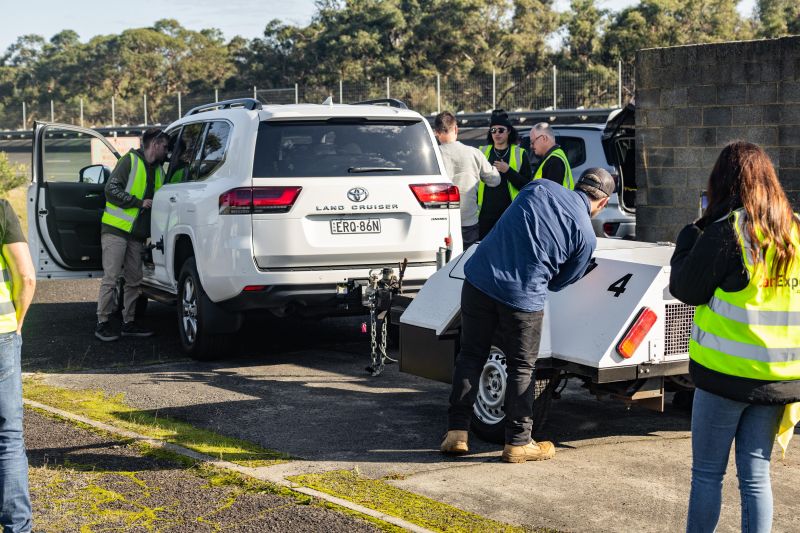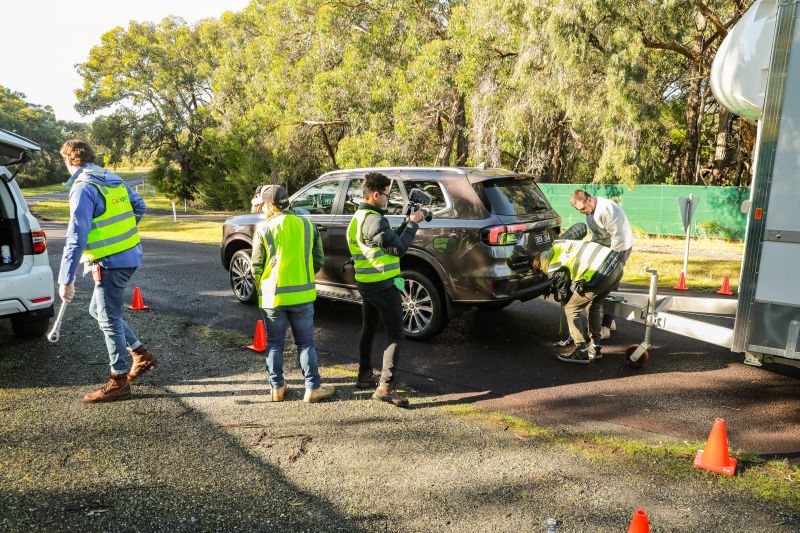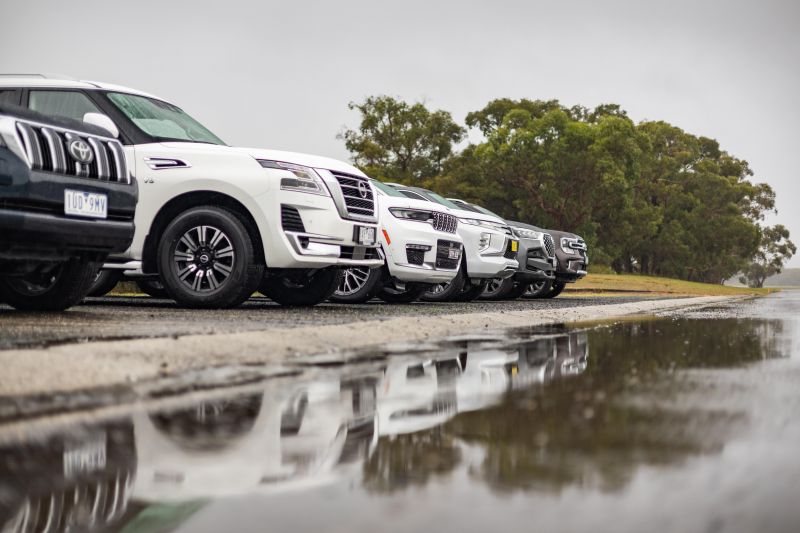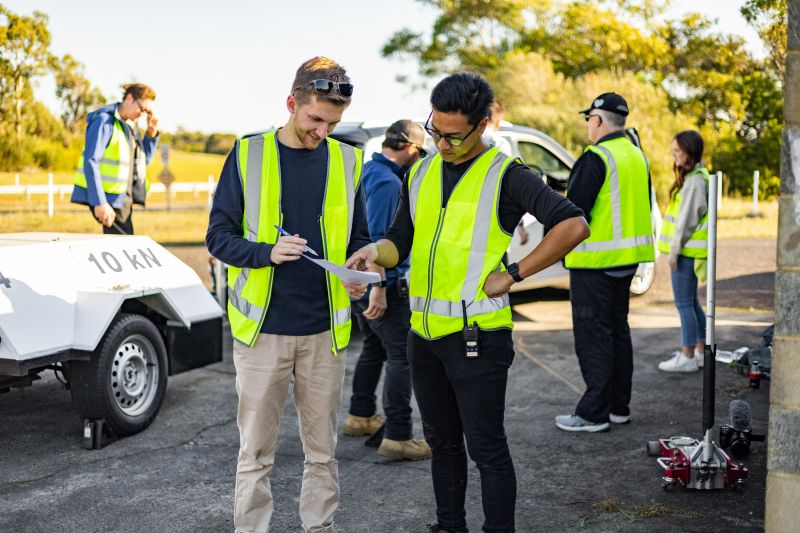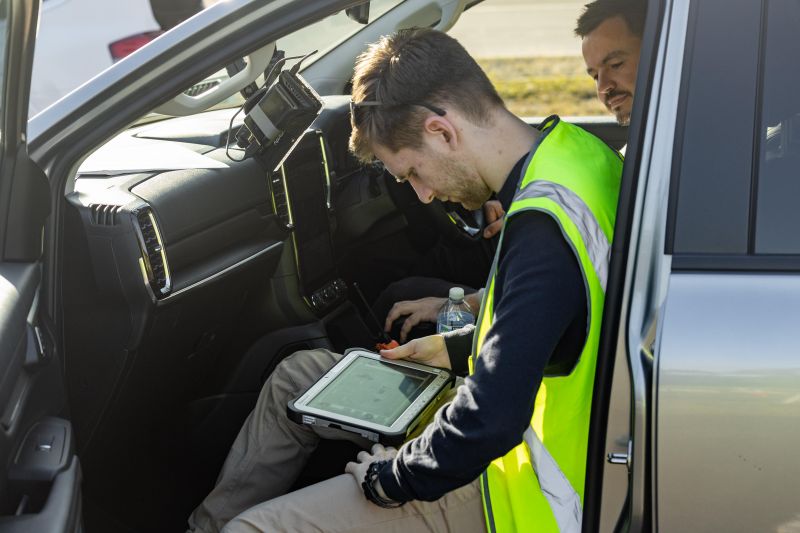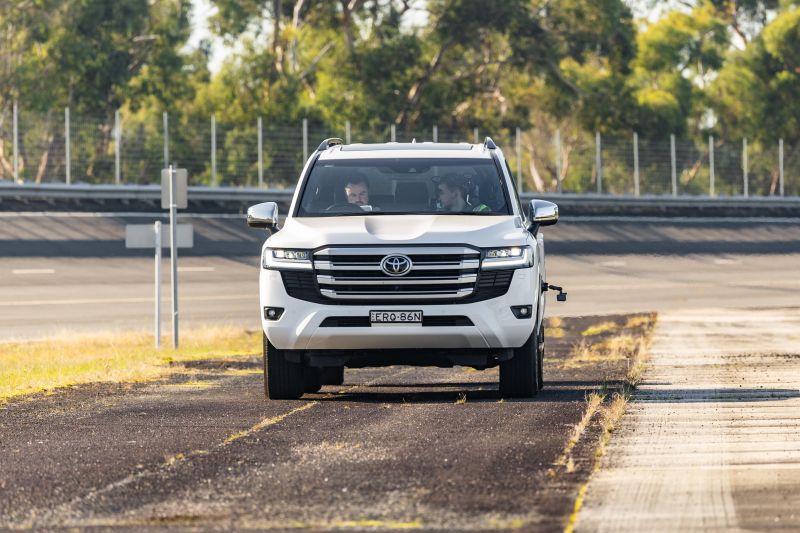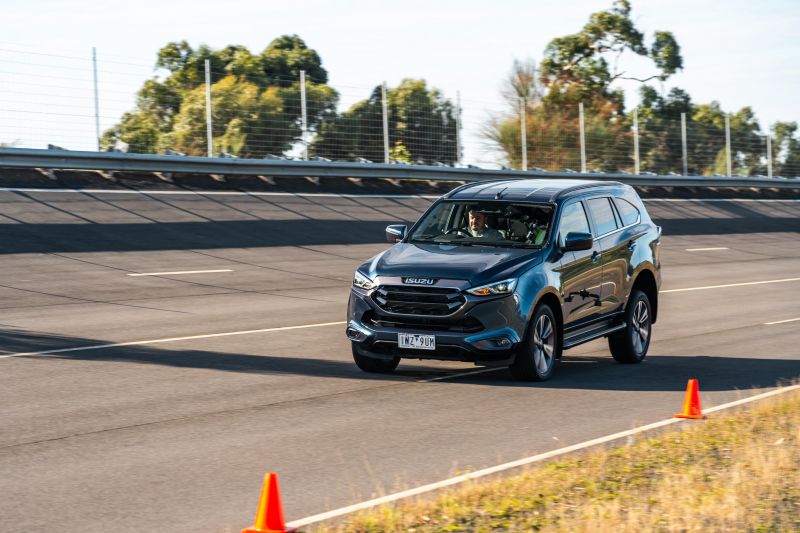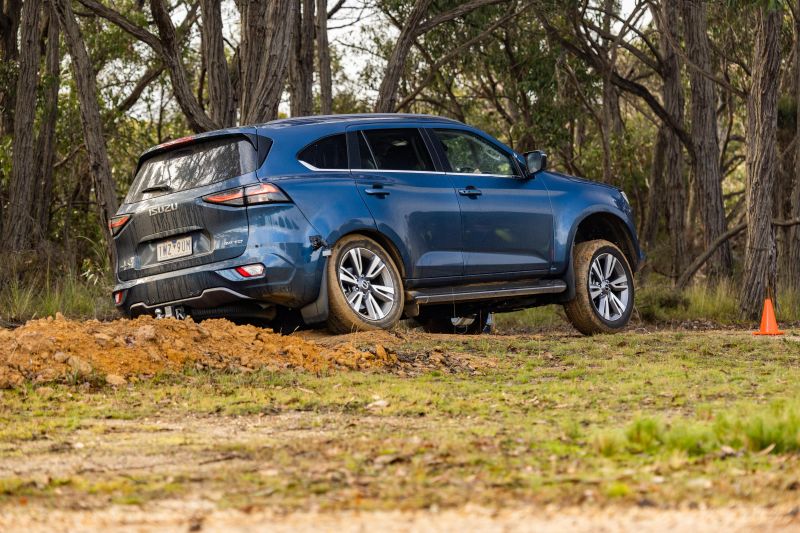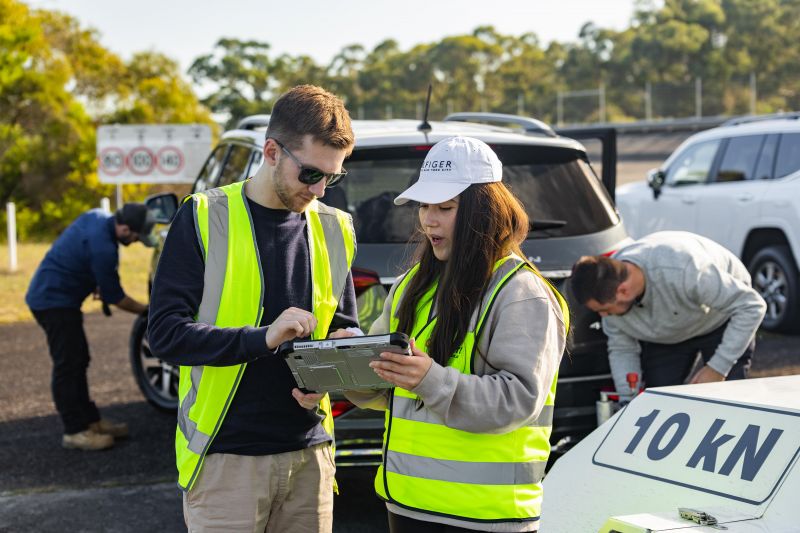I’m James Gelding, and I was fortunate enough to win the previous owner review competition. That competition allowed me to spend a week in Melbourne with the CarExpert team as they conducted last year’s Ute Mega Test. During that test I assisted with collecting and organising the performance data for each vehicle.
Long story short, it was a blast! So I was delighted to receive an offer to join the team once again as they conducted the 4WD SUV mega test!
What happens on a CarExpert Mega Test?
A CarExpert mega test is designed to thoroughly examine the qualities of a large cross section of vehicles that buyers value most. We exhaustively tested their towing abilities, both with a trailer dyne and with a 2800kg box trailer on an ‘alpine’ circuit.
This was complemented with an off-road test and a drag race, because who doesn’t love a good old drag race?
The Mega Test started late on Mother’s Day in the pickup zone at Melbourne Airport. The interstate team gathered and got reacquainted with each other, while watching lead video producer Igor skilfully park a Ford Everest Platinum after two tries and causing a traffic jam. Excitement permeated the atmosphere as the team was briefed and assigned their first vehicle to drive.
Early the next morning, all twelve team members assembled with their vehicles at Lang Lang ready for an action-packed day of filming and testing at the VinFast proving ground. Testing at a proving ground allows us to sample the vehicles in conditions that mimic roads from around the country. In addition, it allows testing to be consistent, safe and repeatable.
We capitalised on favourable weather and started proceedings with the towing test. The high-speed bowl was utilised to collect unladen performance data for all vehicles. This data included acceleration runs, fuel economy readings and an emergency braking test.
Shortly thereafter, the same tests were repeated with a trailer dyne excluding the emergency braking test.
The trailer dyne is a unique and advanced piece of equipment we used to place the vehicle’s drivetrains under significant strain in order to test towing performance. The trailer’s wheels are connected to a computer-controlled retarder that can increase the drag on a vehicle with the press of a button.
This test was extremely useful in determining the effectiveness of a vehicle’s drivetrain, testing laden fuel economy and how various software driven systems behave (such as cruise control).
Next up, we used a 2800kg trailer to test the dynamics at play while a vehicle tows that trailer around Lang Lang’s ‘alpine handling’ circuit. This was one of my favourite facilities as the low-friction pavement and tight switchbacks really put a vehicle through its paces. This only gets more challenging when a vehicle is towing.
This test really encompasses every scenario you could expect to find when towing out on the open road. Excessive suspension sag is punished as the tow vehicles must work hard to maintain control over dips and bumps in the road. The challenge is compounded as the circuit features a steep ascent and long descents which were tackled at a higher speed.
Rounding out our time at Lang Lang, the team used a skid pan to drag race the competitors in a safe and consistent environment. While it all seems like a pointless bit of fun, the races gave us an interesting insight into the comparative performance between the vehicles.
The day that followed was a logistics day (mostly), as we traded the fertile fields of Lang Lang for the mountainous bushland surrounding Anglesea with a spot of go-karting thrown in the mix as well.
Many team members thought they would claim top spot at the kart track (mainly Igor). But alas, hearts were broken and dreams were crushed as Paul took home the top honours – unfortunately something the rest of the team would hear about for the rest of the trip!
The week was rounded out with off-road testing at the Australian Automotive Research Centre at Anglesea. We used several interesting obstacles that vehicles could either pass or fail – in order to add an objective result to reinforce the subjective accounts of vehicles’ performance.
These obstacles included a set of free spinning rollers recessed into a graded hill, a set of offset moguls, a heavily rutted 30 per cent hill climb, and a 45 per cent shaley hill climb and hill descent. To pass these obstacles, vehicles had to have solid mechanical components complemented by well-tuned electronic systems.
That action-packed week was bookended by two logistics days as the organisation behind this test was crucial to its success. Accompanying the great memories from that week were terabytes worth of footage and multiple spreadsheets of data. All footage and data is collated so the written accounts can back up the YouTube videos which are produced shortly after.
What most jumped out at me about the process?
Similar to the ute mega test, the organisation in regard to filming and the care the team took to capture relevant data jumped out at me the most.
Now having the ute mega test under their belts, the members of the video production team were even more methodical with setting up the required shots.
There is an incredible number of microphones and cameras that all need to be charged, have enough storage space and be synced. All these elements can’t miss a beat to not only capture the important moments, but also the B-roll to accompany the main shots as well.
Additionally, photographs were taken inside and out of the vehicles for the written accounts of the testing.
Data collection unfolded in a similar manner. The collection of data was handled in a more efficient manner, permitting the test to run smoothly. The team took great care to record the objective data to back up Paul’s subjective impressions on a vehicle.
The data overlaid on the mega test YouTube videos also gives the consumer an opportunity to compare vehicles they might be interested in. This combines to give CarExpert’s mega tests an overarching quality that is rarely found today.
Which 4WD SUV most impressed me?
A number of these SUVs impressed me. But the one that jumped out at me most might not be what you’d expect.
This test had vehicles that occupied every level of pricing. Starting at the lower end, we had the Mitsubishi Pajero Sport and SsangYong Rexton. Climbing through the mid-range we had vehicles such as the Toyota Fortuner, Isuzu MU-X and the Ford Everest in Trend specification. Go up a rung and we had the top spec Toyota Prado and Ford Everest sporting a V6.
Finally, we had vehicles like the Land Rover Defender, Toyota LandCruiser 300 Series, Lexus LX600 and more as the most expensive vehicles on test.
The more expensive vehicles boasted six and even eight cylinders and plenty of cool features. I was given the job of recording various pieces of data and was lucky enough to ride shotgun through most of the testing, so I got to enjoy the niceties these vehicles offered.
Of particular note was the Land Rover Defender and its air suspension. The air suspension afforded the Defender impressive ride comfort, yet it remained composed when driven around Lang Lang’s ride and handling circuit. On the topic of ride comfort, the Toyota LandCruiser 300 Series was also a highlight, and its turbo-diesel V6 delivered impressive punch.
These vehicles however had sticker prices well above $100,000. When the value proposition is considered, there was one vehicle that impressed me most: the Isuzu MU-X.
After driving the MU-X, it became obvious it hit the bang-for-buck sweet spot. Sure, the Ford Everest boasts more tech and refinement, but the Everest range on the whole is more expensive than that of the MU-X.
Compare the MU-X to the similarly positioned Toyota Fortuner, and stepping inside the Fortuner feels like going back in time – the MU-X simply has a more modern and better-furnished cabin.
The favourable bang-for-buck equation continues with how the MU-X drives. While the Everest and more expensive rivals are more refined, the MU-X well and truly holds its own against established but ageing rivals from Toyota and Mitsubishi.
Its 3.0-litre four-cylinder turbo diesel engine feels under-stressed and the six-speed automatic it’s mated to is a smooth shifter and stayed out of my way completely. Ride quality was good considering the MU-X is a ute-based SUV and a step above the Fortuner it competes with.
Overall, the MU-X is a well-rounded performer while still hitting a value sweet spot.
The 4WD SUV mega test in a nutshell
After gaining experience from the ute mega test, the team worked like a well-oiled machine to produce a set of thorough and high-quality videos that offer concrete results that affirm Paul’s driving impressions.
Being part of performance and tow testing around the legendary Lang Lang proving ground is as fascinating as ever, and conducting an action-packed off-road test finished off the week perfectly.
No week is perfect however, and losing to Paul in karting was definitely a low point. All was forgotten though after seeing Igor’s face when he realised he had to step up onto third place instead of first on the podium!
While the whole team worked hard, the week felt more like a holiday indulging in our passion for cars and the CarExpert team is always great to work with! A massive thank you goes out to the CarExpert team for having me along for another mega test, it was a privilege!
MORE: Best 4WD SUV 2023

